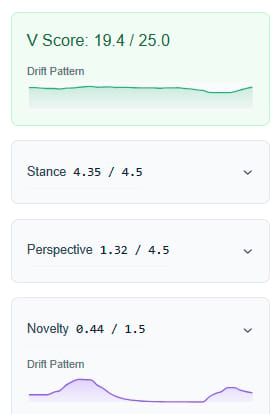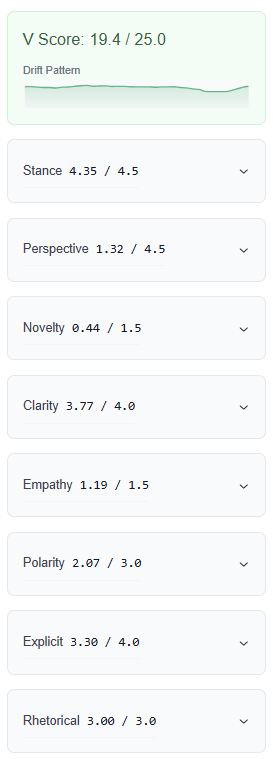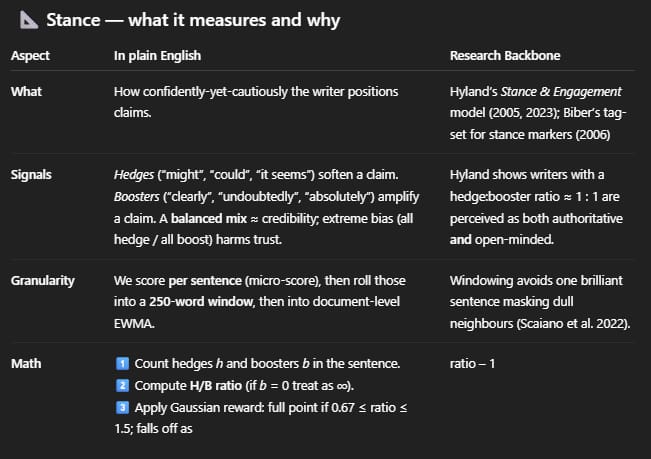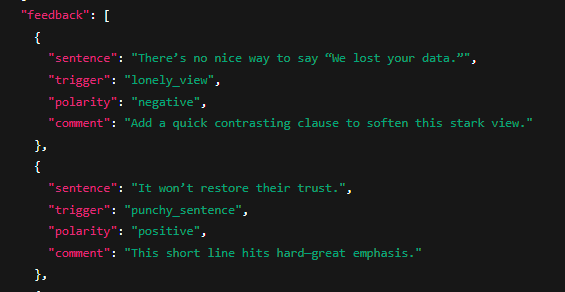- Tim at Penfriend
- Posts
- I broke 37 versions to build THIS: the instant human-or-bot detector
I broke 37 versions to build THIS: the instant human-or-bot detector
+30 studies, 4 levers, instant score on your draft - human-approved beta drops this week.

Day 160/100
Hey—It's Tim.
It’s Monday, which means Penfriend update on what we’re breaking, working on.
Spent the weekend knee-deep in a folder titled “Definitely_Final_VIBE_v37”
(spoiler: not final)
Somewhere between version 34 and 35 the whole thing clicked, and I finally have a playground build of the VIBE score that feels…human.
What is the VIBE score?
Think of it as a polygraph for prose.
Built on 34 peer-reviewed studies of how readers judge authority, emotion, and trust, then distilled into four simple levers:
V Viewpoint – does the piece take a stand or just wave from the sidelines?
I Individuality – can you hear an actual person behind the keyboard?
B Beat – sentence rhythm and on-page structure that pull you forward instead of putting you to sleep.
E Evidence – receipts, not vibes: data, anecdotes, sources, screenshots.
Each paragraph runs the gauntlet, racking up micro-scores that roll up into one brutally honest number.
Science backed. Human approved. Ready to ship.
How we make the mess tidy
Let’s take a look at one of the letters. Viewpoint.
1. Each letter is made up of many smaller checks

V score, with the breakdown of each component, and how it changes across the article
We build each letter’s score via multiple smaller checks. V (Viewpoint) has the most checks, because it turns out that having a view at all is one of the biggest markers that written content will do well.

All the various checks for viewpoint
2. The nice thing about scientific papers is they have formulas
All the 30+ papers we’re using to understand this have a system in how they check. They have to, that’s how science works.
In English, this is how the Stance component works.

I’m going to do a full write up of the entire thing. every component. So you know exactly what is going on.
And with that, we can take it and turn it into code, and then apply it to a whole article. Any article. And then score based on what their output says is most attractive to the reader.

The best part is this analysis is super fast. And, we can take articles we know have done well (Ahrefs analysis, Google Search Console, Medium upvotes etc) and check to see what metrics we’re measuring correlate the most with great content.
3. We can then give you exact feedback based on your writing
I’m still working on this system, but it looks something like this.
With a list of what has been done good, and bad, AND what we know works well in reality, we can take that list of markers, give it to an editing AI that gives you THE USER real time feedback on what is great, good, bad and hurting your content.

It’s up to you if you want to make the changes. I’d imagine we get to a point where you can let Penny make the changes for you, but for now this is the current state of the VIBE score and editor.
Wanna try it?
Reply to this email with the word “VIBE CHECK” and the article you want checked and I’ll send you back the output.
A version for beta testers will be available this week for testing. But for now, you gotta go through me :D
See you tomorrow.

✌️ Tim "The VIBE is goooooooooooood" Hanson
CMO @Penfriend.ai
Same brain, different platforms: X, Threads, LinkedIn.
P.S. I’m wondering what easter eggs we should put in the vibe check…. any ideas?

Penfriend.ai
Made by content marketers. Used by better ones.
What did you think of today's newsletter? |
What to do next
Share This Update: Know someone who’d benefit? Forward this newsletter to your content team.
Get your First 3 Articles FREE EVERY MONTH! We just dropped the biggest update we’ve ever done to Penfriend a few weeks ago. Tone matching with Echo, Hub and Spoke models with Clusters, and BoFu posts.
Let Us Do It For You: We have a DFY service where we build out your next 150 articles. Let us handle your 2025 content strategy for you.